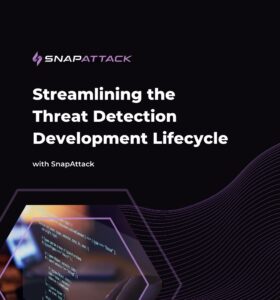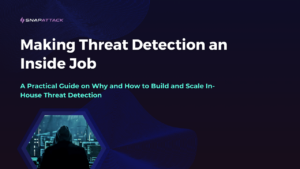Cybersecurity Threat Intelligence (CTI): Why Does It Matter?
Cyber threat intelligence is a powerful research tool that security teams, analysts, and threat hunters leverage to measurably improve their security standing. By operationalizing cyber threat intel to investigate and prepare for incoming threats, security teams gain peace of mind knowing they can stay a step ahead of adversaries in today’s threat landscape.
To effectively operationalize cyber threat intelligence, cybersecurity professionals need to understand what it is, how to use it, which threats to prioritize, and the critical role CTI plays within their organization.
What is Cyber Threat Intelligence (CTI)?
- Internal network logs
- External threat intelligence feeds (from both paid and free sources)
- Social media
- Dark web forums
- And more
This data is then analyzed to prioritize the most pressing threats.
Enacting a threat-informed defense strategy helps security teams leverage threat intel proactively, tracking down the adversary before they even get past your defenses.
Related Resource: Find out how to leverage threat-informed defense in our webinar replay, “Demystifying the Tradecraft of Threat-Informed Defense.”
Benefits of Cyber Threat Intelligence
There are several benefits to operationalizing cyber threat intelligence across the entire security operations life cycle.
PREPARE: Cyber Threat Intelligence Strengthens Risk Management
With a more comprehensive view of how emergent threats stack up against their security landscape, organizations can focus their efforts on the most pressing threats and vulnerabilities, reducing their overall risk profile.
PREVENT: Cyber Threat Intelligence Enhances Visibility
CTI provides organizations with greater visibility into potential cyber threats, including the tactics, techniques, and procedures (TTPs) used by threat actors. With a greater view of the threat landscape, organizations are theoretically better positioned to proactively prioritize and respond to incoming threats.
DETECT: Cyber Threat Intelligence Improves Threat Detection
CTI enables organizations to detect threats earlier so they can take proactive measures to prevent or mitigate the impact of a cyberattack. Researching threats on the horizon or threats already impacting other businesses / industries can help security teams direct their attention and efforts towards what might lie ahead. When security teams get ahead of the threat, they can prevent them from being exploited by threat actors.
RESPOND: Cyber Threat Intelligence Leads to Stronger and Swifter Incident Response
Additionally, threat intelligence can be illuminating for stakeholders and decision makers such as CISOs and SOC managers, as well as their advisors. Mission-critical decisions can be informed by prominent trends and concerns outlined in threat intel data.
Challenges to Operationalizing Cyber Threat Intelligence
Cyber threat intelligence is indispensable to a security team’s threat management strategy. So why do so many organizations struggle to find value in CTI?
CTI CHALLENGE #1: Threat Intelligence Lacks Context
For example, threat intelligence may tell a security analyst that a certain indicator is associated with a certain threat actor. But whether that threat actor poses any pressing danger to their individual organization relies on the security landscape and environment in which they’re operating.
CTI CHALLENGE #2: Teams Don't Know How to Prioritize Incoming Threats
The volume of incoming threats can easily surpass 500 a day For many organizations, at that rate, even putting their top 10 threats into perspective is an immense challenge.
CTI CHALLENGE #3: Teams Don't Have Enough Resources
SnapAttack’s threat intelligence library, IOC hunter, and TTP hunter help you get left-of-boom and break the kill chain earlier.
Try it out in the free Community edition of our platform.
How Organizations Can Operationalize CTI
Organizations utilize cyber threat intelligence to improve their cybersecurity posture in a variety of ways.
STEP 1: Understand Your Security Environment
Organizations utilize cyber threat intelligence to improve their cybersecurity posture in a variety of ways. Some of the key applications of CTI include:
STEP 2: Define Cyber Threat Intelligence Goals
- What are you trying to accomplish in your research?
- Where are you most vulnerable?
- What kinds of attacks have been the most threatening or damaging in the past?
- And what kinds of threat actor behaviors is your network most susceptible to?
Setting these goals can help you prioritize in the vast sea of threat intelligence.
STEP 3: Define Threat Intelligence Roles and Responsibilities
CISOs may use threat intelligence to define business goals, request threat defense budgets, and communicate with shareholders.
- Threat hunters may use threat intelligence to direct their hunts and guide their research.
- Detection engineers may look into threat intelligence when assessing an organization’s detection needs
And so on.
STEP 4: Tailor Threat Intelligence Feeds
Automation can assist with this, as organizations can filter the threat intelligence feeds they’re analyzing to only include those that will impact their organization. CTI vendors and platforms can also provide the structure organizations need when conducting threat intel research.
Operationalizing Threat Intelligence Across Teams
Again, various roles have different responsibilities when it comes to operationalizing threat intelligence.
Threat Hunters: Use Threat Intelligence in Cyber Threat Hunting
CTI is a key component to an organization’s proactive threat hunting strategy. It can be used to guide security teams towards the threats that pose the greatest risk to their organization to proactively identify and respond to them.
Threat hunters analyze network logs and other data sources to identify suspicious activity and investigate potential threats before they result in a cyberattack.
Vulnerability Management: Leverage CTI as Part of Vulnerability Management
Incident Response Teams: CTI and Incident Response
Beyond Internal Teams: Threat Intelligence Sharing
CTI can be shared across organizations and industries to improve their overall cybersecurity posture. The sharing of threat intelligence, especially via established networks such as ISACs and ISAOs, fosters collaboration on threat identification and mitigation, thus improving the security of the entire community.
Conclusion: Make Cyber Threat Intelligence Actionable
It’s easy for security teams to get overwhelmed by cyber threat intelligence – especially when they don’t have the context or clarity to operationalize the vast sea of data they’re looking at. But once they can align their needs, priorities, and threat intelligence feeds in the same direction, cyber threat intelligence becomes a powerful, indispensable tool to security teams of any size or maturity level.
Ready to start operationalizing your threat intel with SnapAttack?
Book a demo today to see how you can finally answer the question, “Are we protected?” with confidence.
 Get even more guidance on how to operationalize CTI with speed and at scale in our free eBook:
Get even more guidance on how to operationalize CTI with speed and at scale in our free eBook:
Streamlining the Threat Detection Development Lifecycle.




